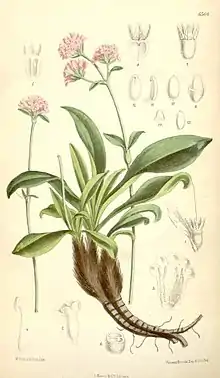Nardostachys jatamansi
Nardostachys jatamansi is a flowering plant of the valerian family that grows in the Himalayas. It is a source of a type of intensely aromatic amber-colored essential oil, spikenard. The oil has, since ancient times, been used as a perfume, as a traditional medicine, and in religious ceremonies. It is also called spikenard, nard, nardin, or muskroot. It is considered endangered due to overharvesting for folk medicine, overgrazing, loss of habitats, and forest degradation.
| Nardostachys jatamansi | |
|---|---|
_03.jpg.webp) | |
| Scientific classification | |
| Kingdom: | Plantae |
| Clade: | Tracheophytes |
| Clade: | Angiosperms |
| Clade: | Eudicots |
| Clade: | Asterids |
| Order: | Dipsacales |
| Family: | Caprifoliaceae |
| Genus: | Nardostachys |
| Species: | N. jatamansi |
| Binomial name | |
| Nardostachys jatamansi | |
| Synonyms[2] | |
| |

Description
Nardostachys jatamansi is a flowering plant of the honeysuckle family that grows in the eastern Himalayas, primarily in a belt through Kumaon, Nepal, Sikkim and Bhutan.[3] The plant grows 10–50 cm (4–20 in) in height and has pink, bell-shaped flowers.[4] It is found at an altitude of 3,000–5,000 m (9,800–16,400 ft). Rhizomes (underground stems) can be crushed and distilled into an intensely aromatic amber-colored essential oil, which is very thick in consistency. Nard oil is used as a perfume, an incense, a sedative, and an herbal medicine said to fight insomnia, birth difficulties, and other minor ailments.[5]
Phytochemistry
Preliminary research on the chemical components of Nardostachys jatamansi indicates the plant contains:[6]
- acaciin
- ursolic acid
- octacosanol
- kanshone A
- nardosinonediol
- nardosinone
- aristolen-9beta-ol
- oleanolic acid
- beta-sitosterol
In spikenard
Nardostachys jatamansi may have been used as an ingredient in the incense known as spikenard, although lavender has also been suggested as a candidate for the spikenard of classical times.[7]
References
- https://www.iucnredlist.org/species/50126627/50131395
- "Nardostachys jatamansi", The Plant List, retrieved 2014-09-19
- Bakhru, H.K. (1993). Herbs that heal : natural remedies for good health (3rd print. ed.). New Delhi u.a.: Orient Paperbacks. p. 117. ISBN 978-8122201338.
- Deyuan Hong, Fred R. Barrie & Charles D. Bell. "Nardostachys jatamansi". Flora of China. 1. Retrieved 6 June 2020 – via eFloras.org, Missouri Botanical Garden, St. Louis, MO & Harvard University Herbaria, Cambridge, MA.CS1 maint: uses authors parameter (link)
- Dalby, Andrew (2000), Dangerous Tastes: the story of spices, London: British Museum Press, ISBN 978-0-7141-2720-0 (US ISBN 0-520-22789-1) pp. 83–88
- Zhang, X; Lan Z; Dong XP; Deng Y; Hu XM; Peng T; Guo P. (January 2007). "Study on the active components of Nardostachys chinensis". Zhong Yao Cai. 30 (1): 38–41. PMID 17539300.
- Fernie, William Thomas (1897). Herbal Simples Approved for Modern Uses of Cure. Philadelphia: Boericke & Tafel. p. 296. OCLC 1191267545.
External links
| Wikisource has the text of the 1911 Encyclopædia Britannica article Spikenard. |
- Original botanical description by David Don from Prodromus Florae Nepalensis (1825), in Latin (archived by the Biodiversity Heritage Library)

